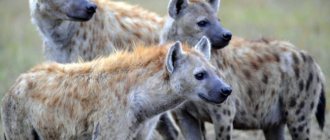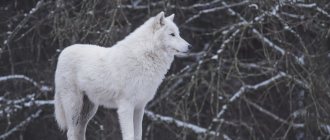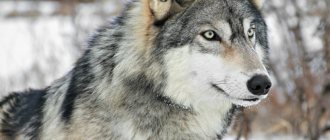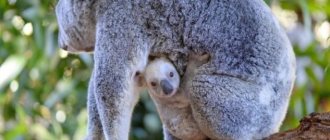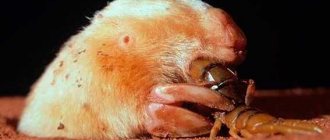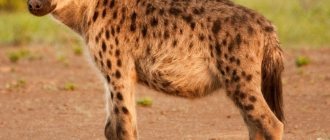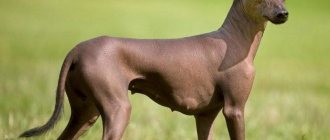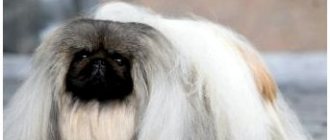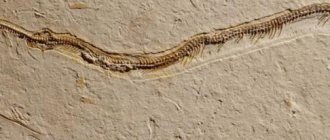- Wild animals
- >>
- Mammals
The marsupial wolf is a now extinct Australian carnivore, one of the largest known carnivorous marsupials, which evolved over about 4 million years.
The last known living animal was captured in 1933 in Tasmania. It is commonly known as the Tasmanian tiger because of its striped lower back or the Tasmanian wolf because of its canine-like characteristics. The marsupial wolf is one of the most legendary animals in the world. But despite its fame, it is one of Tasmania's least understood native species. European settlers were afraid of him and therefore killed him. Only a century after the arrival of white settlers, the animal was brought to the brink of extinction. Full information about the death of the marsupial wolf can be found here.
Origin of the species and description
Photo: Marsupial wolf
The modern marsupial wolf appeared about 4 million years ago. Species of the family Thylacinidae date back to the beginning of the Miocene. Since the early 1990s, seven species of fossil animal have been discovered in part of Lawn Hill National Park in north-west Queensland. Dickson's marsupial wolf (Nimbacinus dicksoni) is the oldest of seven fossil species discovered, dating back to 23 million years ago.
Video: Marsupial wolf
The species was much smaller than its later relatives. The largest species, the powerful marsupial wolf (Thylacinus potens), which was the size of a normal wolf, was the only species to survive the late Miocene. During the late Pleistocene and early Holocene, the latter species of marsupial wolf was common (though never numerous) in Australia and New Guinea.
Interesting fact: In 2012, the relationship between the genetic diversity of marsupial wolves before their extinction was studied. The results showed that the last of the marsupial wolves, in addition to threats from dingoes, had limited genetic diversity due to complete geographic isolation from mainland Australia. Further research confirmed that the decline in genetic diversity began long before humans arrived in Australia.
The Tasmanian wolf shows an example of similar evolution to members of the Canidae family of dogs of the northern hemisphere: sharp teeth, powerful jaws, raised heels and the same general body shape. Because the marsupial wolf occupied a similar ecological niche in Australia as the dog family elsewhere, it developed many of the same features. Despite this, its marsupial nature is not related to any of the placental mammal predators of the Northern Hemisphere.
Arctic (Polar) wolf
The polar wolf (Canis lupus tundrorum) is one of the rarest animals on our planet. The polar wolf's habitat is the Arctic. The wolf is well adapted to the harsh Arctic climate. Its thick, warm, windproof coat helps it survive in extreme temperatures. The wolf has keen eyesight and an excellent sense of smell, which are indispensable in hunting the small living creatures that inhabit these harsh places. Meager supplies of biological food and difficulties in obtaining food lead to the fact that the wolf eats its prey entirely, leaving neither the skin nor bones of the caught animals after the meal. Having an average weight of 60 to 80 kg and a height of up to 80 centimeters, the polar wolf is able to survive without food for several weeks in the event of an unsuccessful hunt, but then can eat up to 10 kilograms of meat at one time. Polar wolves live in packs of up to 10 individuals and hunt polar hares, reindeer and other animals. In one litter of a she-wolf, approximately 3 to 5 cubs are born. The unique fur of the polar wolf has always attracted increased attention from hunters, which has brought the polar wolf to the brink of extinction. Due to global warming and the melting of polar ice, the number of polar wolves continues to decline due to drastic changes in the climate of their usual habitats. Currently, the polar wolf is listed in the Red Book, and hunting it is prohibited.
Appearance and features
Photo: Marsupial or Tasmanian wolf
Descriptions of the marsupial wolf are derived from preserved specimens, fossils, skins and skeletal remains, as well as black-and-white photographs and old film recordings. The animal resembled a large short-haired dog with a stiff tail that smoothly extended from the body in the same way as a kangaroo. A mature individual had a length of 100 to 130 cm, plus a tail of 50 to 65 cm. Weight varied from 20 to 30 kg. Little sexual dimorphism was observed.
All known Australian footage of live marsupial wolves was filmed at Hobart Zoo, Tasmania, but there are two other films filmed at London Zoo. The animal's yellow-brown coat had 15 to 20 distinctive dark stripes on its back, rump, and base of its tail, earning it the nickname "tiger." The stripes are more pronounced in young individuals and disappear as the animal matures. One of the stripes extended down the back of the thigh.
Interesting fact: Marsupial wolves had strong jaws with 46 teeth, and their paws were equipped with non-retractable claws. In females, the baby pouch was located behind the tail and had a fold of skin covering the four mammary glands.
The hair on his body was thick and soft, up to 15 mm long. The coloration ranged from light brown to dark brown, and the belly was cream-colored. The marsupial wolf's round, straight ears were about 8 cm long and covered with short fur. They also had strong, thick tails and relatively narrow snouts with 24 sensory hairs. They had whitish markings near the eyes and ears, and around the upper lip.
Now you know whether the marsupial wolf is extinct or not. Let's see where the Tasmanian wolf lived.
Opening
Australians made first contact with wolves around 1000 BC. e. This is evidenced by rock paintings and engravings.
The marsupial wolf has many names. Local residents called the predator the zebra wolf, hyena, dog, thylacine and Tasmanian wolf. The species was first described by Abel Tasman, who met the marsupial mammal in 1642. The island of Van Diemen's Land where the meeting took place was later named Tasmania.
The first scientific description of the marsupial wolf was published in the proceedings of the Linnean Society of London in 1808 by the amateur naturalist Harris. Since marsupial predators were significantly different from all known species, according to the 1796 classification, a new genus Dasyurus was created. And in 1810, the thylacine was officially assigned to this genus.
Where did the marsupial wolf live?
Photo: Marsupial wolves
The animal probably preferred dry eucalyptus forests, swamps and grasslands on mainland Australia. Local Australian rock art shows that the thylacine lived throughout mainland Australia and New Guinea. Evidence of the animal's existence on the mainland comes from a drained carcass that was discovered in a cave on the Nullarbor Plain in 1990. Newly examined fossilized tracks also indicate the species' historical distribution on Kangaroo Island.
The original prehistoric range of the marsupial wolf, also known as the Tasmanian or thylacine, was thought to have been:
- to most of mainland Australia;
- Papua New Guinea;
- north west Tasmania.
This range has been confirmed by various cave paintings, such as those found by Wright in 1972, and bone collections radiocarbon dated to 180 years earlier. It is known that the last bastion of marsupial wolves was Tasmania, where they were hunted until complete extinction.
In Tasmania, he favored the midlands woodlands and coastal heaths, which eventually became the main destination for British settlers seeking grazing land for their livestock. The striped coloration, which provides camouflage in forest conditions, eventually became the main method of identifying the animal. The marsupial wolf had a typical home range of 40 to 80 km².
Tasmanian wolf in the Red Book
When the Animal Conservation Act was drafted in 1928, the thylacine was not listed as an endangered species. In 1930, the last representative of the wild wolf was shot.
In March 2005, the Australian magazine The Bulletin promised to pay A$1.25 million to the person who caught a live Tasmanian wolf.
Australian authorities passed a law banning the shooting of predators in 1938. This event occurred two years after the death of the last representative of the species at the zoo. The organization of the island reserve in 1966 looks even more incomprehensible. The government has allocated 647 thousand hectares for breeding a non-existent species.
The thylacine had endangered species status until 1980. In 1982, the Tasmanian wolf was declared extinct after the 50-year waiting period had expired. For fifty years, the International Animal Conservation Association has not received any information about surviving individuals.
Main causes of extinction
The main reasons for the extinction of the species can be considered:
- Colonization of territories by competitive predators.
- Mass extermination of individuals by the mast population.
- Worsening epidemiological situation.
- Relocation of a species to unusual habitats.
- Plague of carnivores. The disease was introduced by white settlers with their domestic animals.
In 2012, scientists found that, in addition to all external threats, wolves were facing extinction due to genetic monotony. Due to geographic isolation, the animals only bred within a limited population. This would sooner or later lead to complete extinction.
Is there potential for a revival of the species?
Despite numerous searches in the territories of Tasmania, Australia and New Guinea, no traces of the existence of the thylacine in the wild have been found. All information received from eyewitnesses does not have documentary evidence.
After 1936, there were several reports of wolves appearing in Tasmania. But the information was not confirmed, so the animal was considered a lost species.
Later in 2022, a similar animal was captured on camera traps. The quality of the photographs does not provide a 100% guarantee that this animal is a thylacine.
In November 2022, a report was received from a woman who allegedly encountered a female and cubs in Hartz Mountains National Park. That same year, two travelers saw animals from a car window. In 2022, near the Sleeping Beauty mountain range, a hunter discovered tracks that strongly resembled the fossilized footprint of a thylacine.
Geneticists have been trying to clone the Tasmanian wolf since 1999. The samples are cubs preserved in alcohol. The DNA samples recovered in 2002 were found to be damaged. The first successes were noted only in 2008. However, it has not yet been possible to clone and raise the marsupial predator.
What does a marsupial wolf eat?
Photo: Tasmanian marsupial wolf
Marsupial wolves were carnivores. Perhaps at one time one of the species they ate was a common variety of emu. It is a large flightless bird that shared the wolf's habitat and was exterminated by humans and introduced predators around 1850, coinciding with the decline of the thylacine. European settlers believed that the marsupial wolf preyed on farmers' sheep and poultry.
While examining various samples of Tasmanian wolf den bones, the remains were observed:
- wallaby;
- possums;
- echidna;
- potoroo;
- wombats;
- kangaroo;
- emu.
It has been discovered that animals will only consume certain body parts. In this regard, a myth arose that they preferred to drink blood. However, other parts of these animals were also eaten by the marsupial wolf, such as liver and kidney fat, nasal tissue and some muscle tissue. .
Fun fact: During the 20th century, he was often characterized as primarily a blood drinker. According to Robert Paddle, the popularity of the story seems to have arisen from a single second-hand account heard by Geoffrey Smith (1881–1916) at a shepherd's hut.
An Australian bushman discovered marsupial wolf dens half filled with bones, including those belonging to farm animals such as calves and sheep. In the wild, this marsupial has been documented to eat only what it kills and will never return to the scene of the kill. In captivity, marsupial wolves ate meat.
Analysis of the skeletal structure and observations of the marsupial wolf in captivity suggest that it is a stalking predator. He preferred to single out a particular animal and pursue it until it was completely exhausted. However, local hunters reported that they observed the predator hunting from an ambush. The animals may have hunted in small family groups, with the main group driving the prey in a certain direction, where the attacking individual waited in ambush.
Interesting facts about the animal
Scientists archaeologists have found that the structure of the thylacine's jaw could not contribute to the mass killing of livestock. The jaw muscles of the species were too weak to hunt large animals.
Biologists are still debating the marsupial predator's hunting method. Some claim that they hunted from ambush, others say that predators chased their prey for a long time. Analysis of the skeleton and video materials confirms the version of the pursuing predator.
The thylacine chased the prey until the animal fell from fatigue. Some eyewitnesses talk about driven group hunting. The family group was divided. One part of the animals was chasing prey, while the other was in ambush.
In 1863, a female marsupial wolf jumped from a standing position to a height of 2.5 meters. To jump, these animals used the length of the entire limb and pushed off using their heels. The zoo noted that wolves often stood on their hind legs, balancing with their tails.
Features of character and lifestyle
Photo: Australian marsupial wolf
While walking, the marsupial wolf will keep its head low, like a hound dog searching for a scent, and will stop abruptly to observe its surroundings with its head held high. In zoos, these animals are quite obedient to people and did not pay attention to people cleaning their cages. Which suggested that they were half blinded by sunlight. Most of the time, during the brightest part of the day, the marsupial wolves retreated to their dens, where they lay curled up like dogs.
In terms of locomotion, in 1863 a female Tasmanian wolf was documented to leap effortlessly to the top of the rafters of her cage, 2-2.5m into the air. The first was plantar walking, a characteristic of most mammals where diagonally opposite limbs move alternately, but what was different about Tasmanian wolves was that they used the entire leg, allowing the long heel to touch the ground. This method is not particularly suitable for running. Marsupial wolves have been seen spinning around their paws with only the pads of their feet touching the floor. The animal often stood on its hind legs with its forelimbs raised, using its tail for balance.
Interesting fact: There have been few documented attacks on humans. This only happened when the marsupial wolves were attacked or cornered. It was noted that they had considerable strength.
The thylacine was a nocturnal and crepuscular hunter, spending daylight hours in small caves or hollow tree trunks in a nest of twigs, bark or ferns. During the day he usually hid in the hills and forests and hunted at night. Early observers noted that the animal was generally shy and secretive, aware of the presence of people and generally avoiding contact, although it occasionally displayed inquisitive traits. At that time there was a huge prejudice regarding the “cruel” nature of this beast.
Description of the animal
Before 1808, the thylacine was described ambiguously. The tiger color and ability to climb trees made the wolf look like a tiger. While the structure of the skull and bark strongly resembled a dog. Its long hind legs and pouch made it unlike any species other than the kangaroo.
The structure of the head resembled that of a dog, but the elongated mouth could open so that the upper and lower jaws extended into one line. When the animal yawned, its mouth opened 120 degrees.
What did he look like?
The Tasmanian wolf was considered the largest representative of marsupial predators that ever existed on earth. Descriptions of the species are obtained from video materials, photographs and archaeological finds.
Sexual dimorphism is weakly expressed. An adult male could reach a weight of 25 to 30 kg, females from 20 to 25 kg. The body length of sexually mature individuals from the tip of the nose to the base of the tail is 100–120 cm. The tail is 50–60 cm. The height at the withers is from 40 to 50 cm.
The main body color is from yellow-brown to dark brown, sometimes with a brown tint. The belly has lighter fur. There are dark tiger stripes on the back and rump.
With age, the stripes lost their saturation or faded completely. The younger the individual, the brighter the main color and stripes. There are light markings around the eyes and mouth. The muzzle is light gray or yellow-brown. The hairline is short and thick.
The structure of the hind limbs allowed the animal to make high jumps. The curved bones of the hind legs formed a specific galloping gait. There were no plantar calluses on the hind legs. The claws on the paws did not extend.
The pouch for bearing cubs was formed by a fold of skin and opened back. Marsupial bones were missing. Under the skin fold there are two pairs of nipples for feeding the offspring.
The head is large with an elongated jaw. The skull resembled that of a dog, but was much larger in size. While walking, the wolves lowered their heads to the ground. The ears are short, erect, round in shape and covered with short hair. The teeth are well developed, the total number is 46.
Life expectancy in captivity did not exceed 8 years. Adults had difficulty getting used to new conditions and died. The young animals adapted perfectly, but reproduced very rarely.
Character and lifestyle
The thylacine is a nocturnal and crepuscular predator. During the daytime, animals hid in small caves, bunks under tree roots, hollows or other secluded places.
In the wild, individuals were sometimes found basking in the sun. Zoo workers noted that the animals’ activity in the morning and afternoon was minimal. The wolves took refuge in their lairs and lay curled up in a ball throughout the daylight hours.
Wild animals did not attack people without good reason. Individuals showed aggression only when they were attacked or driven into a corner. It was noted that adult animals tried to avoid contact with people and ran away.
Young representatives of the species were distinguished by their curiosity and sometimes came out to people themselves. Zoo workers calmly cleaned the cages without fear of attack.
Marsupial predators led a predominantly solitary lifestyle. Individuals gathered in small groups only during the mating season and the big hunt. The size of the flock rarely exceeded 4–5 individuals.
What did you eat?
Marsupial wolves are predators, so their main diet included birds, cold-blooded and small animals. It is believed that the main source of food before 1850 was the emu species.
These large flightless birds were completely destroyed by settlers and introduced predators. The extinction of birds may have had a significant impact on the thylacine population. Natural diet of thylacine:
- tree kangaroos;
- echidnas;
- lizards;
- potoroo;
- wallaby;
- opossums;
- wombats;
- lambs;
- calves;
- birds.
Marsupial predators often ate animals that fell into traps, but never returned to the half-eaten prey. This behavior was typical of animals not only in the wild, but also in captivity. The animals refused to eat defrosted or spoiled meat.
The pickiness of the thylacine has given rise to many myths and legends. Predators ate only part of the soft tissue and did not return to their prey. Superstitious residents believed that they drank the blood from the victim and left the meat for the scavengers.
During the hunt, the voice of the marsupial predator resembled the barking of a dog. The difference was in the variety of sounds; they could change in a second from dull to shrill or guttural.
Where did he live?
Marsupial predators were widespread in Australia, Tasmania and New Guinea. A fossilized carcass of a thylacine was found on mainland Australia in 1990. Fossilized footprints were found on Kangaroo Island. After the arrival of settlers and dingoes, wolves completely disappeared from Australia and Papua New Guinea.
Despite the conditional conservation status, the local population of Tasmania and white settlers continued to destroy the Tasmanian wolf population. This was due to the fact that marsupial wolves slaughtered young and stray sheep and calves.
In Australia, animals inhabited savannas, forests and rocky plains. In Tasmania, marsupial predators settled in coastal heaths and dry forest areas. The range of an adult individual could be more than 40 km².
Reproduction
Marsupial wolves belong to the order of mammals. The babies were born not adapted to life in the outside world, so the female carried the puppies in a pouch for 3 to 3.5 months. Usually there were 3-4 puppies in a litter. Grown-up wolf cubs did not leave their mother until 8–9 months.
There are no reliable facts about the breeding period and gestational age. Experts assumed that the mating season lasted from December to February. Eyewitness accounts helped draw such conclusions. It is reliably known that babies emerged from the pouch from approximately May to September. Presumably the pregnancy lasted from 40 to 50 days.
There is only one documented case of wolves breeding in captivity. In 1899, a couple gave birth to 3 puppies at the Melbourne Zoo.
Natural enemies
Thylacines were the largest predators. The reason for the extinction of the species was not natural enemies, but epidemiological impact. In its natural environment, the thylacine had no enemies except humans and hunger. There are known facts when young individuals alone fought off a pack of dogs.
The colonization of the vicinity of the marsupial wolf habitat by dingoes, foxes and raccoon dogs reduced the amount of food. And Tasmanian wolves could not compete with other predators in numbers and reproduction rates.
Research conducted in 2012 confirms that if the epidemiological disaster had not occurred, the species' extinction would have been reversed or delayed indefinitely.
Social structure and reproduction
Photo: Tasmanian marsupial wolf
Tasmanian wolves were secretive animals and their mating patterns were not well understood. Only one pair of male and female marsupial wolves has been documented captured or killed together. This led scientists to speculate that they only came together to mate and were otherwise solitary predators. However, it can also indicate monogamy.
Interesting fact: Marsupials have only been successfully bred once in captivity at Melbourne Zoo in 1899. Their life expectancy in the wild is 5 to 7 years, although specimens in captivity have lived up to 9 years.
Although there is relatively little data on their behavior, it is known that during each season, hunters took the largest number of pups with their mothers in May, July, August and September. Experts estimate that the breeding season lasted approximately 4 months and was separated by a gap of 2 months. It is assumed that the female began to mate in the fall and may have a second litter after the first one leaves. Other sources indicate that births may have occurred continuously throughout the year, but were concentrated in the summer months (December–March). The gestation period is unknown.
Female marsupial wolves put considerable effort into raising their young. It has been documented that they could care for 3-4 babies at a time, carried by the mother in a rear-facing pouch until they could no longer fit in it. The little joeys were hairless and blind, but their eyes were open. The babies were attached to her four nipples. It is believed that the juveniles remained with their mothers until they were at least half adult and were fully furred by this time.
Extinct or not?
In Tasmania, literally a hundred years ago, there were quite a lot of marsupial wolves. However, having tried poultry, sheep and lamb, cattle breeders had a strong conflict with these animals. It was then that the sharp extermination of these predators began.
Marsupial wolves were exterminated with all their might and at every opportunity. They tried to destroy them with poison, deliberately poisoned their food and caught them in traps. At the beginning of the twentieth century, the government began paying people bonuses for each marsupial wolf killed. Even before the Second World War, experts found that up to 20 pairs of marsupial wolves live in the depths of wild forests. Since the 1960s, it has been almost impossible to see this animal. Now the marsupial wolf is completely protected by law. There is still a possibility of encountering a thylacine in dense forests in our time, but no one has managed to do this over the past 40-50 years.
Natural enemies of marsupial wolves
Photo: Wild marsupial wolf
Of all the marsupial predators in the Australasian region, marsupial wolves were the largest. It was also one of the most well-adapted and experienced hunters. Tasmanian wolves, whose origins date back to prehistoric times, were considered one of the top predators in the food chain, making it unlikely that the animal would have been hunted before the arrival of Europeans.
Despite this, marsupial wolves have been classified as extinct due to rampant hunting by humans. Government-sanctioned bounty hunting is readily apparent in surviving historical accounts of animal persecution. At the end of the 18th and beginning of the 19th centuries, the massacre of what people considered a “malicious pest” engulfed almost the entire population. Competition from humans introduced invasive species such as dingoes, foxes, etc., which competed with native species for food. Similar destruction of Tasmanian marsupial wolves has forced the animal past its tipping point. This led to the extinction of one of Australia's most amazing carnivorous marsupials.
Interesting fact: A 2012 study also found that if not for epidemiological impacts, the extinction of the marsupial wolf would have been prevented at best and delayed at worst.
It is likely that numerous factors led to the decline and eventual extinction, including competition with wild dogs introduced by European settlers, habitat erosion, concurrent extinction of predator species, and disease that affected many of Australia's animals.
Lifestyle
The usual habitat of the marsupial wolf is sparse forest and fields. However, as the extermination of the animal began, they moved higher into the mountains and into denser forests. There, animals lived in caves, abandoned burrows and hollows of fallen trees. The marsupial wolf is a nocturnal inhabitant, very rarely people noticed it under the rays of the sun. It was a great success to meet the animal, since they lived alone. Very rarely they hunted in groups or pairs. The marsupial wolf ate small animals:
- lizards;
- proteins;
- wallaby;
- birds;
- mice.
Habitat
It is believed that the homeland of the Tasmanian tiger is Australia and part of New Guinea. Scientists are of the opinion that about three thousand years ago, Tasmanian predators were driven out of their range by stronger and more numerous wild dingoes, which, in turn, were brought to this territory with the help of Aboriginal settlers.
Tasmanian tigers ate the following animals:
- echidnas
- lizards
- birds
After this, historical sources claim that Tasmanian wolves were found exclusively in Tasmania, where there were no dogs. After the resettlement, the wolf population began to grow, however, this process quickly stopped as people began to actively exterminate the animals, believing that they pose a huge danger to the sheep bred in the settlements.
Thylacines ravaged poultry houses, which is why they often became victims of hunters, and also often fell into traps placed throughout their habitat. The population feared not only for their livestock, but also for their own lives, because there were incredible legends about the ferocity, savagery, mercilessness and incredible strength of Tasmanian wolves.
Central Russian forest wolf
Contrary to popular belief, it is this wolf that reaches its maximum size on the Eurasian continent, and not the tundra one. The coloring is classic, and not lightened, like the tundra. The body length of adult Central Russian forest wolves can exceed 160 cm, and the height at the shoulders can reach 1 meter. Of course, such dimensions can only apply to very large individuals. It is generally accepted that on average an adult male weighs 40 - 45 kg, a mature male (about 1 year and 8 months old) weighs about 35 kg, and a mature male (8 months old) weighs 25 kg. She-wolves weigh 15 - 20% less. Anyone who is familiar with old hunting literature, or who has been to “wolf” corners and talked with local residents, has probably read or heard about huge wolves. How much weight can wolves reach? For Central Russia, scientific works indicate a maximum weight in the range of 69 - 80 kg. (Ognev, Zvorykin). And here are the results of weighing specific animals. For the Moscow region - a male weighing 76 kg, the largest of the 250 wolves caught by the wolf hunter V.M. Hartuleri, famous in the thirties and forties of the last century. For Altai - a male weighing 72 kg. The wolf, stuffed of which is in the Moscow State University zoo museum, weighed 80 kg (5 pounds). According to N.D. Sysoev, the head of the state hunting inspection of the Vladimir region, in the period from 1951 to 1963, 641 wolves were killed, of which 17 were especially large. Among these animals, the largest weight was: of males - 79 kg, caught in the Sobinsky district, from females - 62 kg. The footprint of the right front paw of this huge, almost eighty-kilogram animal had a length of 16 and a width of 10 cm. It must be said that wolves of even larger sizes are indicated for Ukraine - 92 kg from the Lugansk region and 96 kg from the Chernigov region, but the conditions for determining the mass of these animals are unknown. The Central Russian forest wolf lives throughout the forest and forest-steppe zones of the European part of Russia, and probably penetrates into Western Siberia. In the north, it is quite possible for it to enter the forest-tundra, however, in the same way as the tundra into the taiga.
We recommend: Lost animals, where should you go to search?
How wolves divide territory
Owning a huge territory, a pack of polar wolves, for example, will, of course, not be able to maintain exclusive rights to it, but wolves living in the forest, whose possessions are much smaller, are forced to clearly recognize the border of their territory. Wolves mark their possessions with the smell of their own body, raising their paws like domestic dogs. They do this especially carefully on the border with the territory of another pack. So that the neighbors understand who they are dealing with and are afraid to violate the border. Smells play an even greater role in communication between wolves than sounds. If one pack of wolves, for example, in the process of hunting, intersects with another, then a bloody showdown with the victims is inevitable, which is why the wolves howl, warning others of their location. Usually the alpha male begins to howl, his howl is picked up by others... When chasing prey, wolves howl, making shorter sounds, notifying their fellows where they are. All wolf packs nearby respond to the howl of one of the packs, and an unimaginable forest cacophony immediately begins. However, it often happens that one of the flocks does not reasonably pick up someone else’s howl, it is numerically too small, and therefore it needs to hide or retreat as quickly as possible for the same reasons. It should be noted that a lone wolf will never howl
Click here to hide text
Melville Island wolf
The Melville Island wolf (Canis lupus arctos), also called the Ellesmere wolf or Arctic wolf, lives in North America on the Arctic island group and northern Greenland. The Melville Island wolf is slightly smaller in size than the common wolf, and its length, from ears to tip of tail, varies from 90 to 180 cm. The wolf reaches a maximum height of 69-79 cm, with a weight of about 45 kg, although especially large , adult males can weigh about 80 kg. The Melville Island wolf's fur is typically light white or grayish. A wolf's ears are small, which helps it efficiently expend heat in low temperatures. For more successful hunting, Melville wolves unite in packs of 5-10 individuals. The main objects of hunting for the Melville Island wolf are reindeer and musk oxen, to which the wolf pack uses driven hunting tactics, attacking mainly weakened prey that cannot offer strong resistance. The wolf's food also includes arctic hares, lemmings and, occasionally, moose. Permafrost is a significant obstacle that makes it difficult for a wolf to set up and dig a den, so wolves use the natural landscape and place their homes in rock ledges, caves or small depressions. The Melville Island wolf gives birth to few cubs, 2-3 cubs per litter, which is largely due to the harsh living conditions in the Arctic climate.
Siberian timber wolf
It is also a large animal, not inferior in its average size to the previous subspecies. According to many scientists, it is still conditionally identified as a separate subspecies, since the taxonomy of Siberian wolves is still poorly developed. The predominant color is light gray, ocher tones are poorly visible or absent altogether. The fur, although not as tall and silky as that of the tundra wolf, is also thick and soft. Its habitat is largely considered to be Eastern Siberia, the Far East and Kamchatka, in addition to the tundra zone, as well as Transbaikalia.

